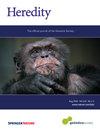Multiple source locations and long-distance dispersal explain the rapid spread of a recent amphibian invasion
IF 3.9
2区 生物学
Q2 ECOLOGY
引用次数: 0
Abstract
Rapid range expansions are characteristic for non-native invasive species when introduced outside their native range. Understanding the dynamics and mechanisms of expanding non-native invasive species is key for regional management. While population genetics and long-term occurrence records are often used in this context, each provides only partial insights, highlighting the need for a combined approach. We demonstrate this synergy using the American bullfrog (Lithobates catesbeianus) invasion in the Grote Nete river valley (Belgium) as a case study. It is commonly believed that this invasion constitutes a single metapopulation established by one primary introduction followed by downstream dispersal. However, recent evidence suggests a more complex scenario, involving introduction at multiple locations and bidirectional dispersal. To differentiate between both scenarios, we analysed nearly three decades of occurrence records and 8592 single nucleotide polymorphisms across 372 individuals from 31 localities, and determined the number of source locations, the range expansion rate, the population genetic structure, and the magnitude and direction of gene flow. We found that invasive spread originated from up to six source locations followed by bidirectional dispersal and downstream long-distance dispersal (LDD) events. Our results suggest that at least two source locations were founded by primary introductions, two from LDD events, while the remaining resulted from secondary introductions. A canal crossing the river was identified as a dispersal barrier, leading to different invasion dynamics on both sides. Our study shows how asynchronous introductions at multiple locations, dispersal barriers, and environmental heterogeneity can lead to distinct spread dynamics within a seemingly continuous and interconnected metapopulation.

多种来源和远距离传播解释了最近两栖动物入侵的快速传播。
当非本地入侵物种被引入其本地范围外时,其特征是范围迅速扩展。了解外来入侵物种扩张的动态和机制是区域管理的关键。虽然在这种情况下经常使用群体遗传学和长期发生记录,但每个都只能提供部分见解,突出了综合方法的必要性。我们使用美国牛蛙(Lithobates catesbeianus)入侵Grote Nete河谷(比利时)作为案例研究来证明这种协同作用。人们普遍认为,这种入侵构成了一个单一的元种群,由一次主要的引入和随后的下游分散建立起来。然而,最近的证据显示了一个更复杂的情况,包括在多个地点引入和双向扩散。为了区分这两种情况,我们分析了来自31个地区的372个个体近30年的发生记录和8592个单核苷酸多态性,并确定了源位置的数量、范围扩展率、群体遗传结构以及基因流动的大小和方向。研究发现,入侵性传播起源于多达6个源头,随后是双向扩散和下游长距离扩散(LDD)事件。我们的研究结果表明,至少有两个源位置是由首次介绍建立的,两个来自LDD事件,其余来自二次介绍。一条穿越河流的运河被认为是一个分散屏障,导致了两侧不同的入侵动态。我们的研究表明,在一个看似连续和相互联系的元种群中,多地点的异步引入、扩散障碍和环境异质性如何导致不同的传播动态。
本文章由计算机程序翻译,如有差异,请以英文原文为准。
求助全文
约1分钟内获得全文
求助全文
来源期刊

Heredity
生物-进化生物学
CiteScore
7.50
自引率
2.60%
发文量
84
审稿时长
4-8 weeks
期刊介绍:
Heredity is the official journal of the Genetics Society. It covers a broad range of topics within the field of genetics and therefore papers must address conceptual or applied issues of interest to the journal''s wide readership
 求助内容:
求助内容: 应助结果提醒方式:
应助结果提醒方式:


